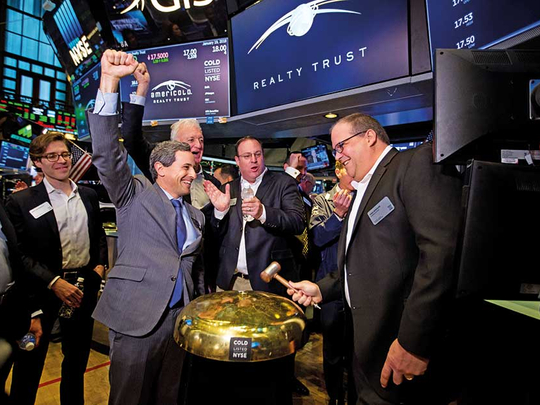
London
As a sea of red spread across global equity and fixed-income markets this week, fans of risky assets are finding reasons to see it merely as a temporary blip.
In their view, a still-strong business cycle can overcome the pullback in monetary stimulus that helped to send the S&P 500 to its worst two-day loss in eight months while Treasuries tumbled. After gaining 6.4 per cent in 2017, the Bloomberg Barclays US Corporate Investment Grade Index is down 1.1 per cent this year even as spreads sit near a decade low.
As the global economic expansion picks up steam, corporate earnings growth will accelerate amid borrowing costs that are still cheap on a historical basis, barricading equity and credit markets from the threat of reduced central-bank stimulus, according to this theory. While Treasury yields rose close to a three-year high this week, optimists say investors are dumping safe assets for a good reason — there’s more money to be made in the risky stuff.
The “sell-off in 10-year Treasuries over past five months is trivial on the face of it,” said Jim Leaviss, the head of retail fixed interest at Prudential Plc’s M&G Investments. “It’s small compared with historical bear marks when a 200 basis point sell-off was common.”
And it’s also worth noting that even after this year’s rout in Treasuries, 10-year yields at 2.7 per cent are still a full percentage point below their 20-year average. Bond demand could pick up as investors such as pension funds rebalance their portfolios to account for the run-up in stock prices, potentially putting a cap on yields.
Strong seasonal demand and modest net issuance thanks to European central-bank purchases will help corporate bonds navigate the interest-rate rout, according to Suki Mann, an independent analyst and former head of credit strategy at UBS Group AG. With corporate credit quality improving, company bonds are becoming all the more appealing as investors hunt for yield, he adds.
“High-grade corporate credit worthiness is improving markedly into a better macro dynamic and financial and non-financial spreads are tightening as a result,” he said.
What’s more, Treasury volatility is projected to say subdued amid stable Federal Reserve policies — a boon for junk debt as the two have tended to move in lockstep.
To be sure, high corporate leverage and tight spreads suggest credit markets have every reason to fret about their capacity to absorb higher rates. But for now, a host of buyers are waiting to ride the monetary tightening cycle, according to Jeroen Blokland, a portfolio manager at Robeco Nederland BV in Rotterdam.
“Buffers are extremely thin, but two types of investors will invest even as rates rise: passive via ETFs, and investors that allocate between government and credit paper,” he said.
A correction in stocks after a euphoric — and overbought — rally would be healthy. But a lot needs to happen to spur a shift in the equity-investment case. European stocks advanced Wednesday, bucking declines in the MSCI Asia Pacific Index.
Take the Fed model for equity valuations, which bulls have seized on in recent years to argue it’s fine to own shares as long as their prices compare favourably to rate markets. While hardly a universally accepted standard, the metric still favours the S&P 500 with an earnings yield 1.6 percentage points above that of the 10-year Treasury.
Even a 3 per cent yield for the 10-year note won’t necessarily presage doom for stocks, according to Vitali Kalesnik, the head of equity research at Research Affiliates LLC. Instead, it may just usher in the return of a healthy financial system with rates moving back to long-term averages, he said.
“Historically speaking, 3 per cent is far from being alarming,” Kalesnik said. When stocks are about to take a nosedive, “normally we would observe a flat or inverted yield curve, which we don’t today.”
Treasury yields may have to go a lot higher before they crush the stock rally.
The line in the sand? Look for a 3.2 per cent yield on the 10-year note, according to Dennis Debusschere, head of portfolio strategy at Evercore ISI, citing a higher equity-risk premium.
“That is when the pain really starts,” he said.












